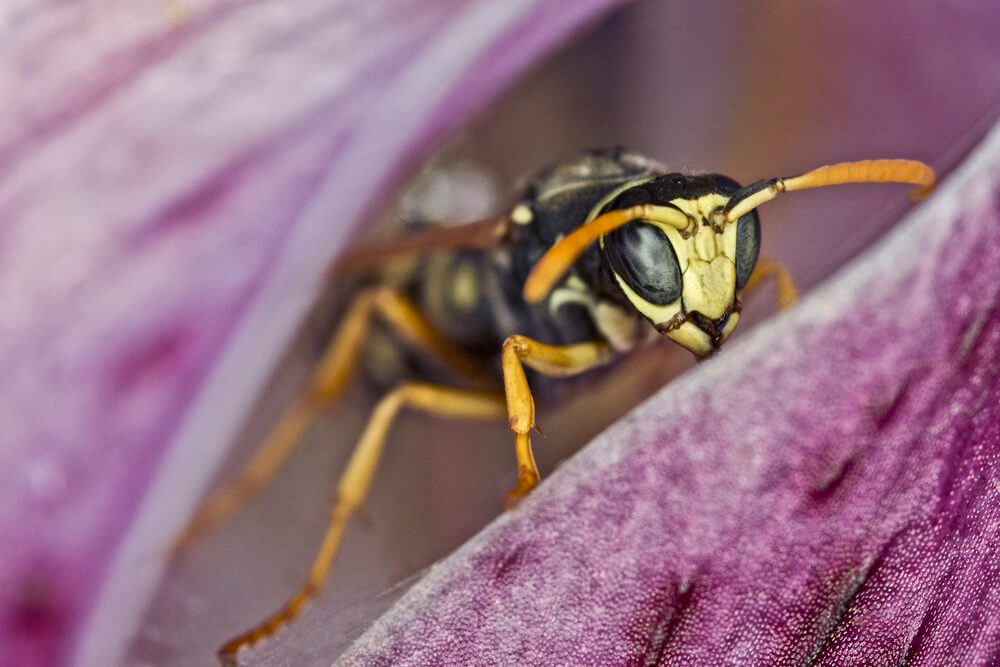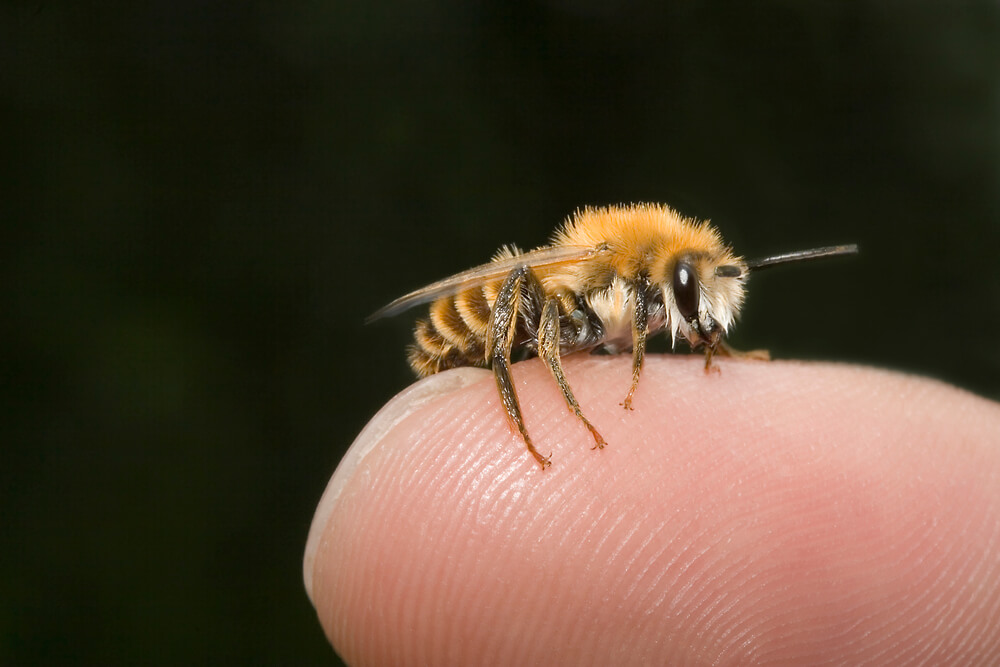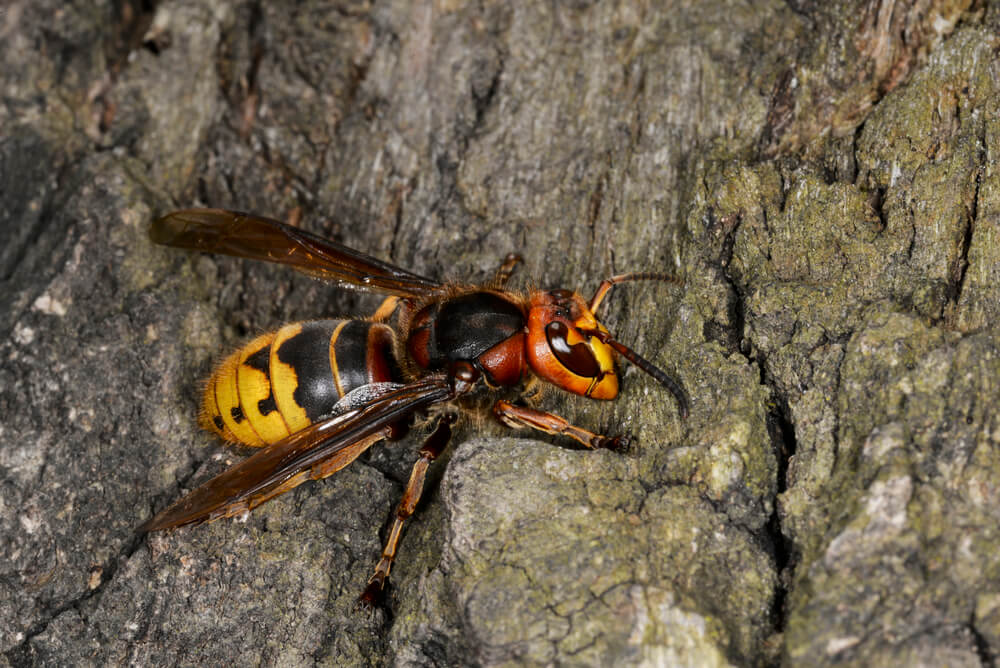What Are Green Bees?
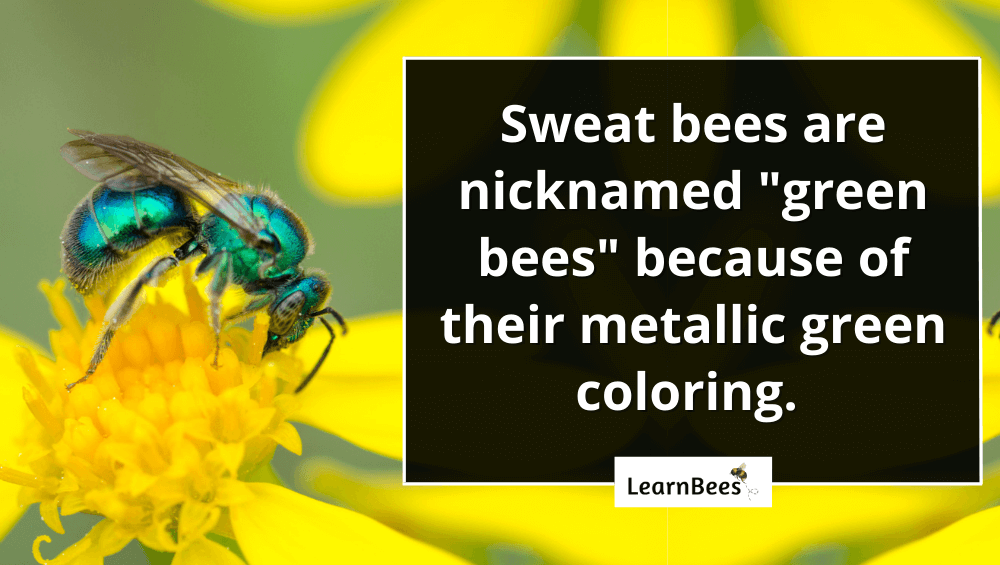
Green bees are a type of bee more formally known as sweat bees. Certain species of sweat bees are metallic green or blue.
But here’s the thing:
Sweat bees are small – only ranging from 1/4 to 1/2 inches long. This makes them about the same size as a house fly. Thanks to their small size, sweat bees go unnoticed by many people.
Additionally, they move quickly and spook easily, so getting a good look at them can be tricky.
More importantly?
Sweat bees live underground in holes they burrow in the soil. They’re also solitary bees that live alone. Meaning, they don’t live in groups like social bees do.
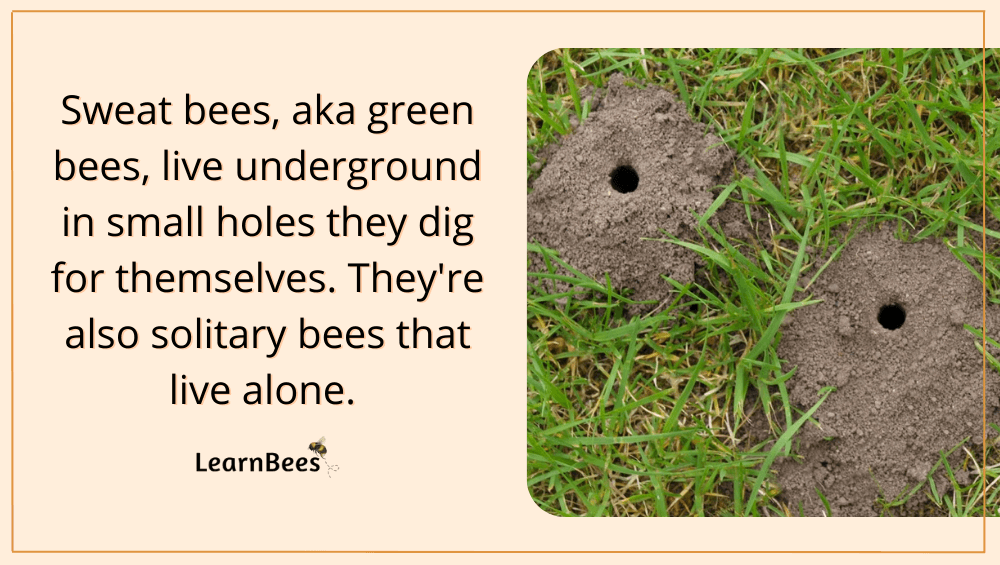
As such, sweat bees aren’t as easily spotted as honeybees or bumblebees.
So now for the million-dollar question:
Why are they called sweat bees?
These bees get their name because they’re attracted to sweat. While they do collect nectar and pollen like other bees, they also drink sweat for its moisture and salt.
So it’s not uncommon for sweat bees to land on sweaty people outdoors, trying to sip on their perspiration for salt and minerals.
Think of it this way:
Sweat bees supplement their diet with salts like athletes drink electrolyte beverages or cows visit salt licks.
It’s also not uncommon to see goats, sheep, deer, and even elephants visit natural salt resources to get the minerals they need like sodium, zinc, calcium, iron, and phosphorus.
Sweat bees are no different. They need salt too.
Now, the question becomes:
Can Green Bees Sting?
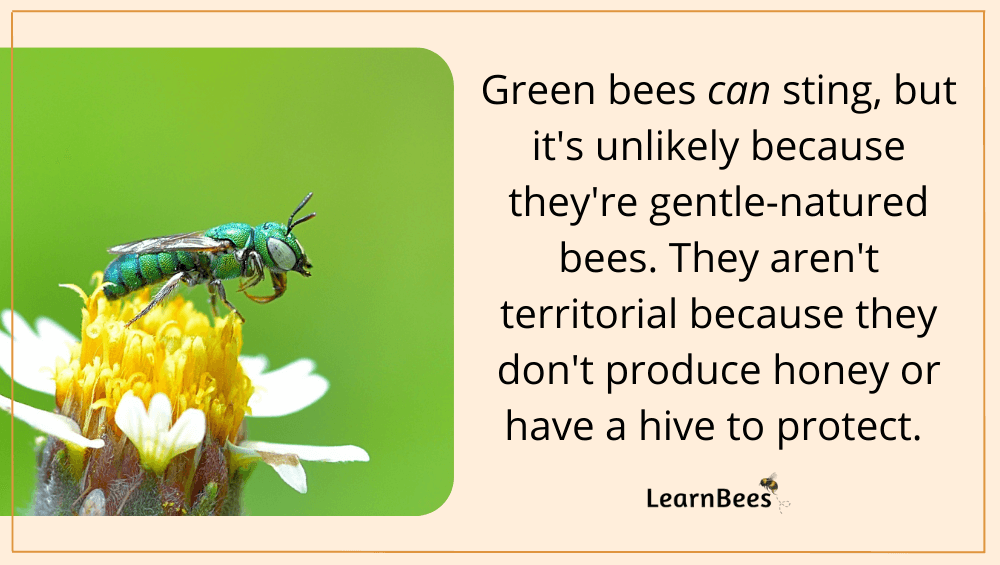
Yes, green bees can sting.
But is it likely? Not really.
Remember that sweat bees (green bees) are solitary bees that live by themselves. They don’t make honey nor live in colonies full of other bees. As such, they have very little to be territorial over.
Take honeybees, for example.
Honeybees are social bees that live in big colonies of up to 60,000 bees. They can make up to 100 pounds of honey each year. This makes honeybees a huge target for predators such as honey badgers, skunks, bears, and other insects.
The same isn’t true for green bees.
Sure, they have predators like any insect does. But they don’t have to protect a hive or honey.
And because of this?
Sweat bees are gentle-natured and won’t sting you for no reason.
And here’s the kicker:
Only female sweat bees can sting. Male bees cannot. This is because stingers are modified egg-laying organs, so only female bees have them.
This rings true for all bee species, including carpenter bees, mason bees, and honeybees.
Are Green Bees Beneficial?
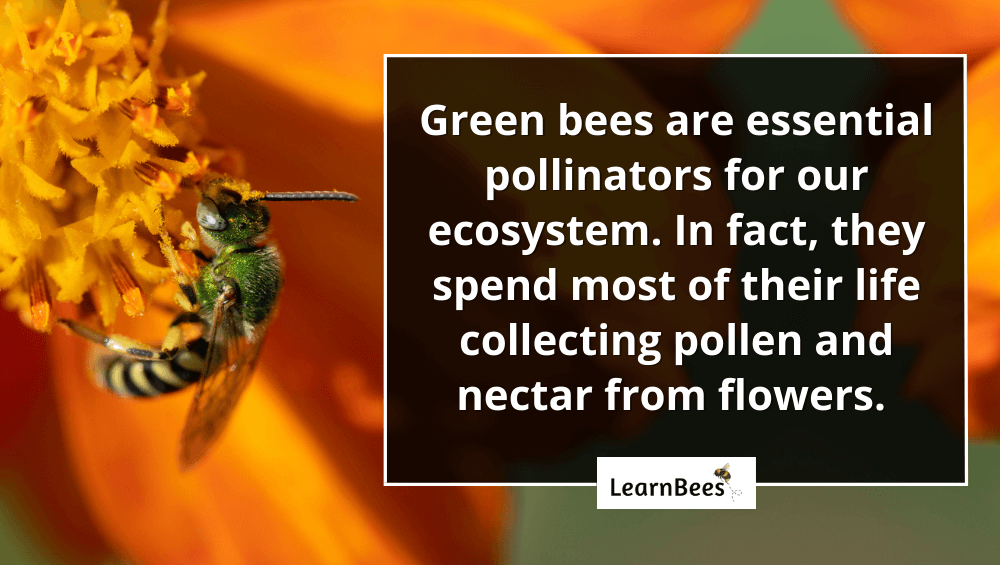
Yes, green bees are beneficial.
For one, they’re crucial pollinators that spend most of their life collecting nectar and pollen from plants. When a green bee flies onto a flower, the hairs on its body collect the pollen grains.
As the bee flies from plant to plant, it leaves a bit of pollen behind every time. Many plants need this type of pollen distribution to produce seeds. This is called cross-pollination.
Even better?
Both bees and plants benefit from pollination.
You see, bee’s mostly eat pollen and nectar from flowers. Nectar is their primary carbohydrate source, while pollen is their primary protein source.
Flowers produce nectar as bait to entice bees to pollinate them. This allows the plants to be cross-pollinated so they can produce seeds.
FAQs on Green Bees
- What kind of bees are green?
- Why would a bee be green?
- Where do green bees live?
- What do green bees eat?
- Are green bees rare?
- How do I get rid of green bees?
- Do green bees produce honey?
- Are green bees aggressive?
- Are green bees solitary or social?
- Where do green bees go in the winter?
- Are green bees actually wasps?
- Are green bees actually hornets?
- Are green bees dangerous?
- Are green bees beneficial?
- Can green bees sting multiple times?
What kind of bees are green?
This is a common question we get, along with others such as:
Is there a green-colored bee? What kind of bee is fluorescent green? What kind of bee is shiny green? What are tiny green bees?
Green bees are sweat bees, which are small bees that are attracted to sweat. They get their name from their habit of landing on humans to collect the sweat and moisture from our skin.
Sweat bees are not aggressive and won’t sting humans unless they feel threatened.
These bees are actually beneficial because they’re important pollinators. They help flowers to cross-pollinate so that the plants can produce seeds.
Unfortunately, it can be tough to get a close look at sweat bees because they’re small and move quickly. And despite their name, not all sweat bees are attracted to sweat.
—> Go back to the FAQs on green bees
More to Explore:
Why would a bee be green?
Simply put, that’s just the color that nature intended for them to be.
Sometimes the bees appear blue or green, depending on how the sun reflects on their bodies. They typically have a green or blue head and thorax. Sometimes they’ll have a yellow and black (or white and black) striped abdomen.
—> Go back to the FAQs on green bees
More to Explore:
Where do green bees live?
Metallic green bees, aka sweat bees, are found worldwide. There are nearly 4,500 species of sweat bees, making them a diverse group that varies in appearance.
—> Go back to the FAQs on green bees
More to Explore:
What do green bees eat?
Like other bees, green bees eat pollen and nectar from flowers.
Pollen is a protein-rich food source that helps bees to grow and develop. Nectar is a carbohydrate-rich food source that provides bees with energy.
As such, this makes bees vegetarian since they don’t eat other insects.
—> Go back to the FAQs on green bees
More to Explore:
Are green bees rare?
Green bees, aka sweat bees, aren’t rare. That said, they’re small bees that go unnoticed by most people. They’re often the size of a house fly. They also fly very fast and get scared off by humans easily.
What’s more, not all sweat bees are green. In fact, most sweat bees are brown or black, which makes them easily mistaken for flies. The most notable sweat bees are the brightly colored ones that are green or blue.
Entomologists note differences in wings, antennae, and other characteristics that allow them to distinguish sweat bees from each other.
Some species of sweat bees are known for being drawn to perspiration, which is rich in moisture and salts.
Also, sweat bees sometimes get confused for cuckoo wasps, which are metallic blue or green wasps. They are not the same. Cuckoo wasps are known for their ability to roll their body into a tight ball that helps protect them from predators.
—> Go back to the FAQs on green bees
More to Explore:
- Do Carpenter Bees Pollinate?
- How Long Do Bumble Bees Live?
- Honeybees vs. Bumblebees: How Do They Compare?
How do I get rid of green bees?
People often ask, “How do you deter green bees?”
Remember:
Green bees aren’t harmful to you or your pets. They’re also beneficial pollinators that are crucial to our ecosystem.
That said, here are a few tips to deter sweat bees:
Tip 1: Water your lawn during the spring and summer
Bees don’t like to nest in wet soil.
Green bees will avoid your lawn if you water it regularly. Also, setting up a sprinkler system can help deter green bees yearly.
And keep in mind:
The best way to repel green bees is to have a thick, luscious lawn that doesn’t have gaps where the bees can dig. Sweat bees burrow into the ground where the grass is sparse. So if you have patches of soil in your yard, then green bees are more likely to burrow there.
Tip 2: Sprinkle cinnamon over your yard
In general, cinnamon is an effective insect repellant. Fortunately, a large container of cinnamon is affordable. It should be sprinkled generously over your lawn.
Do this 1-2 times per week during the warmer months.
And remember:
Sprinkle cinnamon starting in the early spring to prevent bees from nesting from the get-go.
However, if spring has passed, we don’t recommend trying to deter sweat bees already nesting.
It’s better to leave the nests alone until the following year before nesting begins. You don’t want to disturb the sweat bees because they’re vital pollinators.
—> Go back to the FAQs on green bees
More to Explore:
Do green bees produce honey?
No, green bees (sweat bees) do not produce honey.
Despite popular belief:
Most types of bees don’t produce honey. Honeybees and bumblebees are the exceptions. Both of these bees produce honey. With that said, honeybees are the only type of bee that makes enough honey for humans to eat. So all the raw honey you see at the grocery store comes from honeybees.
—> Go back to the FAQs on green bees
More to Explore:
- Ground Bees: Are They a Threat to Your Yard?
- Wasps vs. Honeybees: Are They Different?
- Do Bumble Bees Bite?
Are green bees aggressive?
No, green bees are not aggressive. In fact, they’re quite docile and gentle.
They don’t produce honey or have a colony to defend. This means they aren’t territorial like other bees.
So unless you poke around their nest or try to grab them, you usually don’t have to worry about getting stung by a green bee.
—> Go back to the FAQs on green bees
More to Explore:
Are green bees solitary or social?
Green bees are solitary, which means they don’t live in colonies.
Instead, each female green bee builds her own nest.
During the spring and summer, you might see several green bees flying around your yard. But they’re not working together. Instead, each bee is busy gathering food for her own nest.
You’re more likely to see green bees during the daytime because they’re active pollinators. At night, they return to their nests to sleep.
—> Go back to the FAQs on green bees
More to Explore:
Where do green bees go in the winter?
Sweat bees usually overwinter as pupae or larvae in the nest that the adult sweat bee made for them. As the temperature rises, they will emerge as adults in the spring. Many sweat bee species only live three to four months.
—> Go back to the FAQs on green bees
More to Explore:
Are green bees actually wasps?
No, sweat bees and wasps are two entirely different species of insects.
However, they are often confused with one another because they can look similar. Some species of wasps are metallic green or blue.
That said, there are more than 20,000 species of bees and 30,000 species of wasps, so they are a large group with diverse insects.
—> Go back to the FAQs on green bees
More to Explore:
Are green bees actually hornets?
No, hornets and green bees are two separate species. Hornets actually fall under the wasp category, while bees are a different category altogether.
At first glance, some hornets might be confused for a bee. But usually, hornets are larger and less fuzzy than bees.
—> Go back to the FAQs on green bees
More to Explore:
Are green bees dangerous?
Green bees aren’t considered dangerous because they aren’t aggressive and don’t produce honey. This means they aren’t territorial like other bee species can be.
You don’t have to worry about them around your pets or other people.
The only time you might want to be wary of them is if you’re allergic to bee stings. All bee stings can cause an allergic reaction in some people. So if you’re allergic, it’s best to avoid all bee species – not just green bees.
—> Go back to the FAQs on green bees
More to Explore:
Are green bees beneficial?
People often ask, “Are green bees good?”
Green bees, or sweat bees, are actually beneficial to have around.
That’s because they help pollinate plants. So if you have a garden, then you want green bees around. They’ll help your plants grow and produce fruit or vegetables.
Not to mention, they’re gentle creatures that mind their own business. So they won’t bother you or your family unless you bother them first.
—> Go back to the FAQs on green bees
More to Explore:
Can green bees sting multiple times?
Yes, green bees can sting multiple times. This is because they have smooth stingers that don’t get stuck inside our skin. As such, they’re able to fly away with their stinger intact.
However, they usually only sting humans if they feel threatened. So unless you’re bothering them or their nest, you don’t have to worry about getting stung.
And even if you do get stung, it’s not as painful as a wasp sting. So, green bees aren’t something you should fear.

